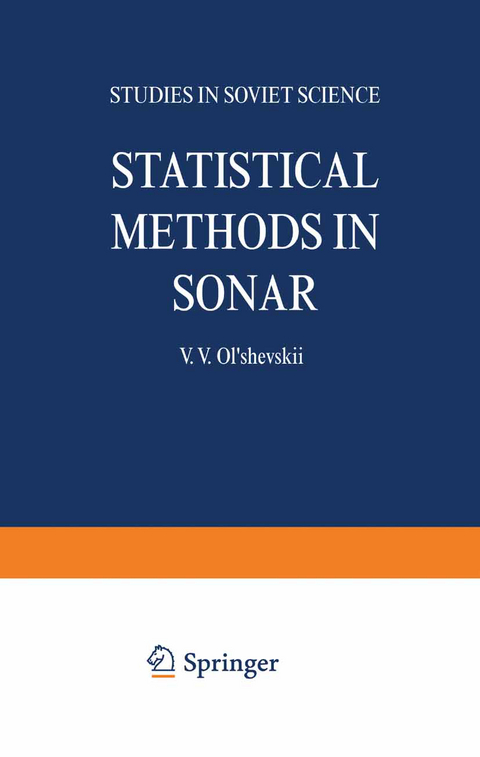
Statistical Methods in Sonar
Springer-Verlag New York Inc.
978-1-4757-0476-1 (ISBN)
I. Introductory Remarks.- §1. Some Definitions.- §2. The Sonar Model.- §3. Sonar and Radar.- §4. Statistical Problems of Sonar.- II. Procedural Fundamentals of Experimental Research in Sonar.- §5. Principal Tasks of Experimental Research.- §6. The Structural Diagram of Quantitative Experimental Research.- §7. Discrimination Functional of the Probability Characteristic and Its Statistical Estimate.- §8. The Base Model.- §9. Interpretation of Experimental Results.- §10. Objects of Experimental Research in Sonar.- III. Probability Models of Hydroacoustic Signals.- §11. Varieties of Models.- §12. A Priori Information and Probability Models.- §13. Methods for Describing Hydroacoustic Signals in Terms of Probability.- §14. Classification of Hydroacoustic Signals.- §15. Canonical Models.- §16. Parametrical Models.- §17. Additive-Multiplicative Constructive Models.- §18. Models in the Form of Oscillations with Random Amplitude and Phase.- §19. Complex Representation of Signals.- IV. The Emitted Signals.- §20. Signal Classification.- §21. Complex Representation of Emitted Signals.- §22. Ambiguity Function and Diagrams.- §23. Signals with Sinusoidal Occupation.- §24. Frequency-Modulating Signals.- §25. Noiselike Signals.- V. Echo Signals.- §26. Classification of Objects of Research and the Conditions under Which They Are Observed.- §27. Representation of Echo Signals and Their Probability Characteristics.- §28. The Model of an Echo Signal of Known Form with Constant Lag and Change in Time Scale.- §29. Echo Signal with Fluctuating Amplitude.- §30. Echo Signal Consisting of an Additive Mixture of a Signal of Known Form and a Random Component.- §31. Echo Signal with Random Amplitude Modulation.- §32. Echo Signal with Random Phase Modulation.- §33.Echo Signal with Random Frequency Modulation.- §34. Model of an Echo Signal in the Form of a Sum of Elementary Signals.- VI. Marine Reverberation.- §35. Classification of Reverberatory Signals.- §36. Discrete Canonical Model of Reverberation.- §37. Complex Representations.- §38. Characteristics of the Random Parameters of Elementary Scattered Signals.- §39. Average Value of Reverberation.- §40. Autocorrelation Function for the Complex Envelope of Reverberation.- §41. Energy Spectrum of the Complex Envelope of Reverberation.- §42. Evaluation of the Frequency-Time Cross-Correlation Function for the Complex Envelopes of the Emitted Signal and Reverberation.- §43. Generalization for the Case of Elementary Scattered Signals of Different Forms.- §44. Space-Time Correlation of Reverberation when Wideband Signals Are Emitted.- §45. One-Dimensional Semi-invariants.- §46. Probability Distributions for Instantaneous Values of Reverberation and Its Envelope.- VII. Problems of Detecting Echo Signals in the Presence of Interference.- §47. Specific Features of Detecting Echo Signals in Sonar.- §48. Probability Characteristics of Detection.- §49. Typical Probability Distributions of the Output Effect.- §50. Incoherent Detection of Simple Echo Signals with a Linear Detector.- §51. Incoherent Detection of a Noiselike Echo Signal with Quadratic Detection and Smoothing (“Energy Detection”).- §52. Coherent Detection of a Noiselike Echo Signal Using Cross-Correlation Processing.- §53. The Effect of Reverberation Interference on Echo Signal Detection.- §54. Detection with Multichannel Systems, and Discussion of Results.- VIII. Elements of the Theory of Statistical Measurement.- §55. Basic Stages of Statistical Measurements.- §56. Statistical Measurement Errors.-§57. Formation of a Statistical Estimate.- §58. Statistical Measurement Errors of the Characteristics of Nonstationary Homogeneous Random Processes.- §59. Optimization of the Parameters of the Statistical Measuring System.- §60. Adaptive Optimization.- IX. Inverse Probability Problems in Sonar.- §61. Direct and Inverse Problems.- §62. Correctness Conditions.- §63. Determination of the Probability Density for the Rates of Movement of Scatterers.- §64. Determination of the Spectrum of the Fluctuations in the Rate of Movement of Scatterers.- §65. Determination of the Relative Level of Coherent Scattering.- §66. Determination of the Average Number of Scatterers.- §67. Determination of the Frequency Properties of Scatterers.- §68. Determination of the Spatial Distribution of Scatterers.- Conclusion.
| Erscheint lt. Verlag | 26.7.2012 |
|---|---|
| Reihe/Serie | Reihe Wissenschaft |
| Zusatzinfo | XX, 242 p. |
| Verlagsort | New York, NY |
| Sprache | englisch |
| Maße | 152 x 229 mm |
| Themenwelt | Naturwissenschaften ► Physik / Astronomie ► Optik |
| Technik ► Elektrotechnik / Energietechnik | |
| ISBN-10 | 1-4757-0476-3 / 1475704763 |
| ISBN-13 | 978-1-4757-0476-1 / 9781475704761 |
| Zustand | Neuware |
| Haben Sie eine Frage zum Produkt? |
aus dem Bereich


